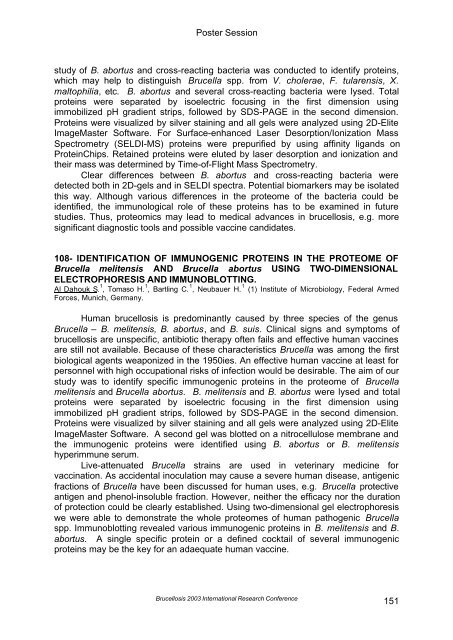Brucellosis 2003 proceedings - PHIDIAS
Brucellosis 2003 proceedings - PHIDIAS
Brucellosis 2003 proceedings - PHIDIAS
You also want an ePaper? Increase the reach of your titles
YUMPU automatically turns print PDFs into web optimized ePapers that Google loves.
Poster Session<br />
study of B. abortus and cross-reacting bacteria was conducted to identify proteins,<br />
which may help to distinguish Brucella spp. from V. cholerae, F. tularensis, X.<br />
maltophilia, etc. B. abortus and several cross-reacting bacteria were lysed. Total<br />
proteins were separated by isoelectric focusing in the first dimension using<br />
immobilized pH gradient strips, followed by SDS-PAGE in the second dimension.<br />
Proteins were visualized by silver staining and all gels were analyzed using 2D-Elite<br />
ImageMaster Software. For Surface-enhanced Laser Desorption/Ionization Mass<br />
Spectrometry (SELDI-MS) proteins were prepurified by using affinity ligands on<br />
ProteinChips. Retained proteins were eluted by laser desorption and ionization and<br />
their mass was determined by Time-of-Flight Mass Spectrometry.<br />
Clear differences between B. abortus and cross-reacting bacteria were<br />
detected both in 2D-gels and in SELDI spectra. Potential biomarkers may be isolated<br />
this way. Although various differences in the proteome of the bacteria could be<br />
identified, the immunological role of these proteins has to be examined in future<br />
studies. Thus, proteomics may lead to medical advances in brucellosis, e.g. more<br />
significant diagnostic tools and possible vaccine candidates.<br />
108- IDENTIFICATION OF IMMUNOGENIC PROTEINS IN THE PROTEOME OF<br />
Brucella melitensis AND Brucella abortus USING TWO-DIMENSIONAL<br />
ELECTROPHORESIS AND IMMUNOBLOTTING.<br />
Al Dahouk S. 1 , Tomaso H. 1 , Bartling C. 1 , Neubauer H. 1 (1) Institute of Microbiology, Federal Armed<br />
Forces, Munich, Germany.<br />
Human brucellosis is predominantly caused by three species of the genus<br />
Brucella – B. melitensis, B. abortus, and B. suis. Clinical signs and symptoms of<br />
brucellosis are unspecific, antibiotic therapy often fails and effective human vaccines<br />
are still not available. Because of these characteristics Brucella was among the first<br />
biological agents weaponized in the 1950ies. An effective human vaccine at least for<br />
personnel with high occupational risks of infection would be desirable. The aim of our<br />
study was to identify specific immunogenic proteins in the proteome of Brucella<br />
melitensis and Brucella abortus. B. melitensis and B. abortus were lysed and total<br />
proteins were separated by isoelectric focusing in the first dimension using<br />
immobilized pH gradient strips, followed by SDS-PAGE in the second dimension.<br />
Proteins were visualized by silver staining and all gels were analyzed using 2D-Elite<br />
ImageMaster Software. A second gel was blotted on a nitrocellulose membrane and<br />
the immunogenic proteins were identified using B. abortus or B. melitensis<br />
hyperimmune serum.<br />
Live-attenuated Brucella strains are used in veterinary medicine for<br />
vaccination. As accidental inoculation may cause a severe human disease, antigenic<br />
fractions of Brucella have been discussed for human uses, e.g. Brucella protective<br />
antigen and phenol-insoluble fraction. However, neither the efficacy nor the duration<br />
of protection could be clearly established. Using two-dimensional gel electrophoresis<br />
we were able to demonstrate the whole proteomes of human pathogenic Brucella<br />
spp. Immunoblotting revealed various immunogenic proteins in B. melitensis and B.<br />
abortus. A single specific protein or a defined cocktail of several immunogenic<br />
proteins may be the key for an adaequate human vaccine.<br />
<strong>Brucellosis</strong> <strong>2003</strong> International Research Conference<br />
151
















